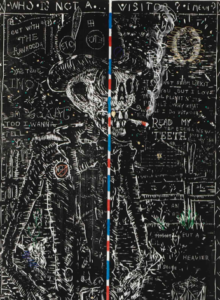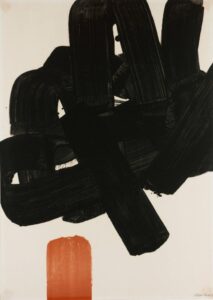Today’s post comes from Simone Levine, Class of 2013 and Art Center Student Docent.

While reading Brian O’Doherty’s Inside the White Cube for an art history class I am taking this semester, I came across a section on how the work of Frank Stella operates within the gallery space. I was immediately reminded of Stella’s Slieve Bawn, and through O’Doherty’s perspective found a new understanding of how this work operates within the white-walled gallery of the Art Center.
Slieve Bawn is an unconventionally shaped canvas that reminds me of the triangular head of an arrow. Running along this wedge shape are parallel lines that direct my gaze toward their convergence at the point of the wedge, then launch my gaze along a projectile that extends beyond the point of the canvas and across the white wall of the gallery space behind it. In reading O’Doherty’s work, I recognized the true power of this phenomenon: Stella’s canvases direct the viewer to see how his work helps us acknowledge the space of the gallery.
O’Doherty asserts that Stella’s canvases “powerfully activated” the wall behind them; their shape rebelled against conventional rectangular canvases and “formally confirmed the wall’s autonomy, altering for good the concept of the gallery space.”O’Doherty includes a photo of Stella’s 1960 installation at Leo Castelli Gallery in New York, which shows how Stella’s installation transformed the entirety of the white cube through the large-scale works individually exhibited on each of gallery’s walls. Hanging among the many rectangular works of the Art Center’s collection, Stella’s Slieve Bawn has a different effect on the white cube of the Art Center’s galleries. The juxtaposition of Stella’s wedge with works of more conventional formats ultimately highlights the power of Stella’s canvas, for we realize the authority of the white cube that exhibits Slieve Bawn among the master painters of centuries past.





It is especially striking where it is placed right next to “The Harvest” by Agnes Martin, a canvas that seems to sink into the white wall. “The Harvest” contains thousands of squares both inside the canvas and around the frame. The Stella piece almost acts as an arrow pointing to it, or a mathematical less than sign…